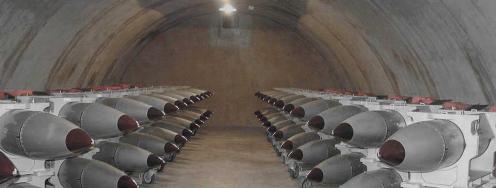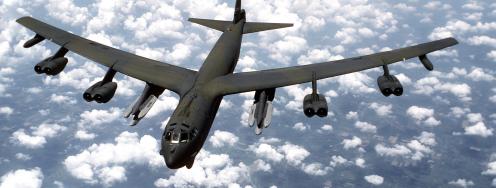Bomber Fleet to Get New Nuclear Cruise Missile
On the radar: Sanctions and behavior; New guided nuclear bomb; China’s posture paper; and Grading the nonproliferation regime.
On the radar: Sanctions and behavior; New guided nuclear bomb; China’s posture paper; and Grading the nonproliferation regime.
April 22, 2013 | Edited by Benjamin Loehrke
Stealth standoff addition - The Air Force is plans to build a Long Range Standoff nuclear cruise missile (LRSO) that can be delivered by the B-52, B-2 and the proposed Long-Range Strike Bomber. The B-2, which currently lacks the ability to deliver cruise missiles, would receive new military capabilities to penetrate advanced air defense systems if equipped with the LRSO.
--Design costs for the new missile are going to top $1 billion over the next five years, hinting that the full cost of the weapon - including its refurbished nuclear warheads - will easily be billions of dollars more. Hans Kristensen at Strategic Security has the analysis. http://bit.ly/1240TrR
Sanctions effectiveness - “Despite some of their limitations, sanctions have proved themselves to be effective,” writes Meir Javedanfar. He notes that Iran’s willingness to discuss specific proposals in negotiations with the P5+1 and Iran’s move to turn 20% enriched uranium into fuel rods both came about in the wake of EU oil sanctions.
--Takeaway: “Sanctions on their own are by no means a silver bullet. Both sides need to show commitment to the diplomatic process, to show willingness to compromise and to address each other's concerns.” Full article in The Guardian. http://bit.ly/124mJv8
Welcome to Early Warning - Subscribe to our morning email or follow us on twitter.
--Have a tip or feedback for the editor? Email earlywarning@ploughshares.org earlywarning@ploughshares.org. Want to support this work? Click here.
Tweet - @AliVaez: Iran to meet U.N. nuclear watchdog on May 21: reports @Reuters. http://t.co/L1AsBfMS42
Nuclear budget buster - The U.S. is planning to spend over $11 billion to build a new, guided nuclear bomb to replace the nonstrategic nuclear weapons in Europe. The proposed B61-12 bomb will have new military capabilities, which challenges the Obama administration’s pledge to not add new nuclear weapons or missions to the U.S. nuclear arsenal.
--"The billions of dollars we are lavishing on the B61 is criminal. This is billions of dollars spent on a weapon whose mission evaporated at the end of the cold war. It's clearly aimed at buying senators' votes," said Joe Cirincione. Full story from Julian Borger at The Guardian. http://bit.ly/ZDXbFb
Hagel in Israel - “Defense Secretary Chuck Hagel opened a weeklong visit to the Middle East on Sunday by pressing an American agenda focused on deterring Iran — including a significant new weapons deal for Israel — coupled with a strong caution that it would be premature for Israel to opt for unilateral strikes on Tehran’s nuclear program,” report Thom Shanker and Isabel Kershner for The New York Times. http://nyti.ms/109etpv
Reading China’s posture paper - A recent Chinese white paper on defense did not explicitly refer to China’s “no first use” nuclear posture, bringing some analysts to wonder if China is moving away from its long-held strategy. M. Taylor Fravel suggests the absence of reference to “no first use” in the paper might be due to the new structure of the paper, which now lacks a chapter on defense policy.
--Fravel recommends that the U.S. and China have a dialogue on nuclear weapons to clear up the confusion, but does not see signs that China is dramatically changing its nuclear posture. Full article in The Diplomat. http://bit.ly/ZDPcIm
Nonpro report card - A new “Global Governance Report Card” from the Council on Foreign Relations graded the performance of the nuclear nonproliferation regime.
--Grades: Strengthening Normative and Legal Frameworks (Average), Checking State Proliferators (Poor), Interdicting Illicit Nuclear Transfers (Average), Securing Fissile Material (Good), Oversight of Civil Nuclear Programs (Poor) and Disarmament (Average). The U.S. earned a “Most Improved” award, while Iran and North Korea earned “Detention.”
--The report recommends that the NPT be updated to include long-term goal of mitigating the spread of nuclear weapons and material, while nuclear weapons state “should make cuts to their nuclear arsenals to the minimum credible deterrent” as a step toward multilateral disarmament. Full nuclear report card here. (pdf) http://on.cfr.org/13qGe1a
Missiles moved - North Korea moved two short-range Scud missile launchers to its east coast, a South Korean news agency reported. Story by Jane Chung of Reuters. http://reut.rs/109eGsT
Events:
--”What is at Stake in the US-ROK 123 Agreement?” Amb. Christopher Hill, Gary Samore, Sharon Squassoni and Victor Cha. April 22 from 3:00-4:00 PM at CSIS. Details here. http://bit.ly/17ILEoS
--Senate Armed Services Subcommittee on Emerging Threats and Capabilities, hearing on Proliferation Prevention Programs. Madelyn Creedon, Kenneth Myers, and Anne Harrington. April 23, 2:30 p.m. @ 222 Russell Senate Office Building. Webcast here. http://owl.li/kbQOG
--”Iran’s Nuclear Ambitions: Costs, Risks, and Motivations” Ali Vaez, James Acton, Mohammad jahan-Parvar and Karim Sadjadpour discuss a new report. April 25 from noon-1:45pm at Carnegie. Details here. http://bit.ly/15zOM9I
--”The Media & Iran’s Nuclear Program: An analysis of U.S. and U.K. coverage, 2009-2012” Jonas Siegal and Saranaz Barforoush present a new study, followed by discussion with John Steinbruner, Susan Moeller, Reza Marashi and Walter Pincus. April 29th from 9:00-10:30am at the Woodrow Wilson Center. http://bit.ly/13qzY9r



